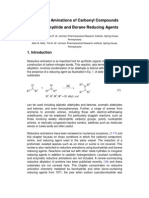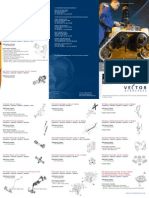Cable Assembly
Uploaded by
alexiswalker509Cable Assembly
Uploaded by
alexiswalker509How to Choose the Right Cable Assembly for Your Project
Connecting devices and systems is the backbone of modern technology, and the key to
a seamless connection lies in selecting the right cable assembly. Whether you're
building a complex industrial control system, setting up a home theater, or simply
connecting a computer to a monitor, choosing the appropriate cable assembly is crucial
for optimal performance and reliability.
Understanding Cable Assembly Basics
A cable assembly is a pre-made, ready-to-use electrical or electronic cable that
connects two or more devices or components. It consists of one or more conductors,
usually enclosed in an insulating jacket, and often includes connectors at each end.
The right cable assembly for your project depends on several factors, including:
● Application: What will the cable be used for? (e.g., data transmission, power
supply, signal transmission)
● Environment: Where will the cable be installed? (e.g., indoor, outdoor, harsh
conditions)
● Signal Type: What kind of signals will the cable carry? (e.g., analog, digital,
high-speed data)
● Length: How long does the cable need to be?
● Connector Type: What type of connectors are required at each end?
Key Considerations for Choosing a Cable Assembly
1. Cable Type:
● Coaxial Cable: Suitable for transmitting high-frequency signals, often used in
video and audio applications.
● Twisted Pair Cable: Used for transmitting data signals, commonly found in
Ethernet networks.
● Fiber Optic Cable: Ideal for high-speed data transmission over long distances,
used in telecommunications and data centers.
● Power Cable: Designed to carry electrical power, used in appliances, equipment,
and electrical installations.
2. Conductor Material:
● Copper: The most common conductor material, offering good conductivity and
affordability.
● Aluminum: Lighter and less expensive than copper, but with lower conductivity.
● Fiber Optic: Uses light pulses to transmit data, providing high bandwidth and low
signal loss.
3. Insulation:
● PVC: A common, cost-effective insulation material, suitable for general-purpose
applications.
● Teflon: Offers excellent heat resistance and chemical resistance, ideal for
demanding environments.
● Cross-Linked Polyethylene (XLPE): Provides high dielectric strength and moisture
resistance, suitable for power cables.
4. Jacket Material:
● PVC: Durable and cost-effective, suitable for indoor and outdoor applications.
● Nylon: Offers high abrasion resistance, ideal for cables subjected to wear and
tear.
● Polyurethane: Provides excellent flexibility and resistance to oils and chemicals.
5. Connector Type:
● RJ-45: Commonly used for Ethernet connections.
● HDMI: Used for high-definition video and audio transmission.
● USB: A versatile connector for data transfer and power supply.
● BNC: Used for coaxial cable connections, often found in video surveillance
systems.
6. Cable Assembly Length:
● Custom Lengths: Cable assemblies can be custom-made to your exact
specifications.
● Standard Lengths: Pre-made assemblies are available in various standard
lengths.
7. Environmental Considerations:
● Temperature Range: The cable should be able to withstand the temperature
extremes of its operating environment.
● Moisture Resistance: Consider the cable's moisture resistance if it will be
exposed to water or humidity.
● Chemical Resistance: Choose a cable with appropriate chemical resistance if it
will be exposed to chemicals or solvents.
8. Certification and Standards:
● UL: Underwriters Laboratories, a safety testing organization, certifies cable
assemblies for specific applications.
● CSA: Canadian Standards Association, another safety testing organization.
● RoHS: Restriction of Hazardous Substances, a directive that limits the use of
certain hazardous materials in electronic equipment.
9. Cable Assembly Manufacturer:
● Reputation: Choose a reputable manufacturer with a proven track record of
quality and reliability.
● Technical Support: Ensure that the manufacturer provides adequate technical
support.
● Warranty: Consider the warranty offered by the manufacturer.
10. Cost:
● Budget: Determine your budget for the cable assembly.
● Value for Money: Choose a cable assembly that offers the best value for your
money.
Choosing the Right Cable Assembly for Your Needs
By carefully considering these factors, you can select the right cable assembly for your
project, ensuring optimal performance, reliability, and safety.
For example:
● If you are setting up a home theater, you will need a high-quality HDMI cable
assembly to transmit high-definition video and audio signals.
● If you are building a network infrastructure, you will need Ethernet cable
assemblies with RJ-45 connectors.
● If you are connecting industrial equipment, you will need a cable assembly that
can withstand harsh environments and high temperatures.
Where to Find Cable Assemblies
Cable assemblies are widely available from a variety of sources, including online
retailers, electronics stores, and industrial suppliers.
If you need a custom-made cable assembly, you can contact a specialized cable
assembly manufacturer.
Remember, choosing the right cable assembly is essential for the success of your
project. By taking the time to carefully consider your needs, you can ensure that you
select a cable assembly that will provide reliable and long-lasting performance.
You might also like
- Ansi/Tia 570B: Residential Telecommunications Infrastructure StandardNo ratings yetAnsi/Tia 570B: Residential Telecommunications Infrastructure Standard33 pages
- 10 Methods To Reduce Cost in Your Cable AssemblyNo ratings yet10 Methods To Reduce Cost in Your Cable Assembly26 pages
- Define The Wiring Standards and Allow For Two Different Wiring Color CodesNo ratings yetDefine The Wiring Standards and Allow For Two Different Wiring Color Codes9 pages
- Module 2: Cable Layout and Installation Equipment Is Set Up in Accordance With Manufacturer'S and Job RequirementsNo ratings yetModule 2: Cable Layout and Installation Equipment Is Set Up in Accordance With Manufacturer'S and Job Requirements4 pages
- Wire and Cable: The Industry Standard For Rugged, Reliable PerformanceNo ratings yetWire and Cable: The Industry Standard For Rugged, Reliable Performance6 pages
- Network Design. Guide To Cabling.: WhitepaperNo ratings yetNetwork Design. Guide To Cabling.: Whitepaper6 pages
- Ethernet and Bus Cables For Industrial Automation. Reliable Datacommunication With Draka ICSNo ratings yetEthernet and Bus Cables For Industrial Automation. Reliable Datacommunication With Draka ICS6 pages
- CCTV Cables & Connectors: From The Rockpile Security Buyer's GuideNo ratings yetCCTV Cables & Connectors: From The Rockpile Security Buyer's Guide11 pages
- Hayes_and_Rosenberg - Data, voice, and video cabling-Chp3No ratings yetHayes_and_Rosenberg - Data, voice, and video cabling-Chp37 pages
- How_to_wire_your_own_ethernet_cables_andNo ratings yetHow_to_wire_your_own_ethernet_cables_and13 pages
- 4 - 2015 - Catalog - ABB Cable Accessories 7.2-42 KV - English - IntroductionNo ratings yet4 - 2015 - Catalog - ABB Cable Accessories 7.2-42 KV - English - Introduction6 pages
- Network Infrastructure Enterprise Catalog EMEA NCCB94No ratings yetNetwork Infrastructure Enterprise Catalog EMEA NCCB9420 pages
- Cabling Techniques With Diagram:: Straight CableNo ratings yetCabling Techniques With Diagram:: Straight Cable4 pages
- Steps To Designing Structured Cabling SystemsNo ratings yetSteps To Designing Structured Cabling Systems6 pages
- Anixter Installation Pocket Reference Guide enNo ratings yetAnixter Installation Pocket Reference Guide en86 pages
- Latest Network Cable To Be Installed - Google SearchNo ratings yetLatest Network Cable To Be Installed - Google Search1 page
- Ultimate Guide: Wiring, Updated 10th Edition: Meets Current National Electrical Code StandardsFrom EverandUltimate Guide: Wiring, Updated 10th Edition: Meets Current National Electrical Code StandardsNo ratings yet
- BICSI RCDD Registered Communications Distribution Designer Exam Prep And Dumps RCDD-001 Exam Guidebook Updated QuestionsFrom EverandBICSI RCDD Registered Communications Distribution Designer Exam Prep And Dumps RCDD-001 Exam Guidebook Updated QuestionsNo ratings yet
- Trilogy of Connectors: Basic principles and connector design explanationsFrom EverandTrilogy of Connectors: Basic principles and connector design explanationsNo ratings yet
- ASTM A182 F22 Flange - Alloy Steel F22 Socket Weld - Threaded FittingsNo ratings yetASTM A182 F22 Flange - Alloy Steel F22 Socket Weld - Threaded Fittings5 pages
- Feed Restriction in Broiler Chickens Production ANo ratings yetFeed Restriction in Broiler Chickens Production A20 pages
- Reductive Amination of Carbonyl Compounds With Borohydride and BoranNo ratings yetReductive Amination of Carbonyl Compounds With Borohydride and Boran170 pages
- (BP Process Safety Series) BP Safety Group-Safe Furnace and Boiler Firing-Institution of Chemical Engineers (IChemE) (2005)100% (6)(BP Process Safety Series) BP Safety Group-Safe Furnace and Boiler Firing-Institution of Chemical Engineers (IChemE) (2005)86 pages
- MY THOUGHTS ABOUT "A Beautiful Mind": Daro, Farhannah T. Bsn-3No ratings yetMY THOUGHTS ABOUT "A Beautiful Mind": Daro, Farhannah T. Bsn-31 page
- EW2002 AP 0610 Web - SVI2Ap With Remote SensorNo ratings yetEW2002 AP 0610 Web - SVI2Ap With Remote Sensor160 pages
- Admissions Guidebook For Holders of Diploma or Equivalent Qualifications - 2024 - 2025 - 0No ratings yetAdmissions Guidebook For Holders of Diploma or Equivalent Qualifications - 2024 - 2025 - 0520 pages
- Handbook: For International Students at ETH ZurichNo ratings yetHandbook: For International Students at ETH Zurich72 pages
- Patanjali Yoga Sutra: Chapter 2 - Sadhana PadaNo ratings yetPatanjali Yoga Sutra: Chapter 2 - Sadhana Pada3 pages
- Ansi/Tia 570B: Residential Telecommunications Infrastructure StandardAnsi/Tia 570B: Residential Telecommunications Infrastructure Standard
- Define The Wiring Standards and Allow For Two Different Wiring Color CodesDefine The Wiring Standards and Allow For Two Different Wiring Color Codes
- Module 2: Cable Layout and Installation Equipment Is Set Up in Accordance With Manufacturer'S and Job RequirementsModule 2: Cable Layout and Installation Equipment Is Set Up in Accordance With Manufacturer'S and Job Requirements
- Wire and Cable: The Industry Standard For Rugged, Reliable PerformanceWire and Cable: The Industry Standard For Rugged, Reliable Performance
- Ethernet and Bus Cables For Industrial Automation. Reliable Datacommunication With Draka ICSEthernet and Bus Cables For Industrial Automation. Reliable Datacommunication With Draka ICS
- CCTV Cables & Connectors: From The Rockpile Security Buyer's GuideCCTV Cables & Connectors: From The Rockpile Security Buyer's Guide
- Hayes_and_Rosenberg - Data, voice, and video cabling-Chp3Hayes_and_Rosenberg - Data, voice, and video cabling-Chp3
- 4 - 2015 - Catalog - ABB Cable Accessories 7.2-42 KV - English - Introduction4 - 2015 - Catalog - ABB Cable Accessories 7.2-42 KV - English - Introduction
- Network Infrastructure Enterprise Catalog EMEA NCCB94Network Infrastructure Enterprise Catalog EMEA NCCB94
- Latest Network Cable To Be Installed - Google SearchLatest Network Cable To Be Installed - Google Search
- Ultimate Guide: Wiring, Updated 10th Edition: Meets Current National Electrical Code StandardsFrom EverandUltimate Guide: Wiring, Updated 10th Edition: Meets Current National Electrical Code Standards
- BICSI RCDD Registered Communications Distribution Designer Exam Prep And Dumps RCDD-001 Exam Guidebook Updated QuestionsFrom EverandBICSI RCDD Registered Communications Distribution Designer Exam Prep And Dumps RCDD-001 Exam Guidebook Updated Questions
- Trilogy of Connectors: Basic principles and connector design explanationsFrom EverandTrilogy of Connectors: Basic principles and connector design explanations
- Electronic Connectors: With Pinouts and Typical PricesFrom EverandElectronic Connectors: With Pinouts and Typical Prices
- ASTM A182 F22 Flange - Alloy Steel F22 Socket Weld - Threaded FittingsASTM A182 F22 Flange - Alloy Steel F22 Socket Weld - Threaded Fittings
- Reductive Amination of Carbonyl Compounds With Borohydride and BoranReductive Amination of Carbonyl Compounds With Borohydride and Boran
- (BP Process Safety Series) BP Safety Group-Safe Furnace and Boiler Firing-Institution of Chemical Engineers (IChemE) (2005)(BP Process Safety Series) BP Safety Group-Safe Furnace and Boiler Firing-Institution of Chemical Engineers (IChemE) (2005)
- MY THOUGHTS ABOUT "A Beautiful Mind": Daro, Farhannah T. Bsn-3MY THOUGHTS ABOUT "A Beautiful Mind": Daro, Farhannah T. Bsn-3
- Admissions Guidebook For Holders of Diploma or Equivalent Qualifications - 2024 - 2025 - 0Admissions Guidebook For Holders of Diploma or Equivalent Qualifications - 2024 - 2025 - 0
- Handbook: For International Students at ETH ZurichHandbook: For International Students at ETH Zurich

























































































